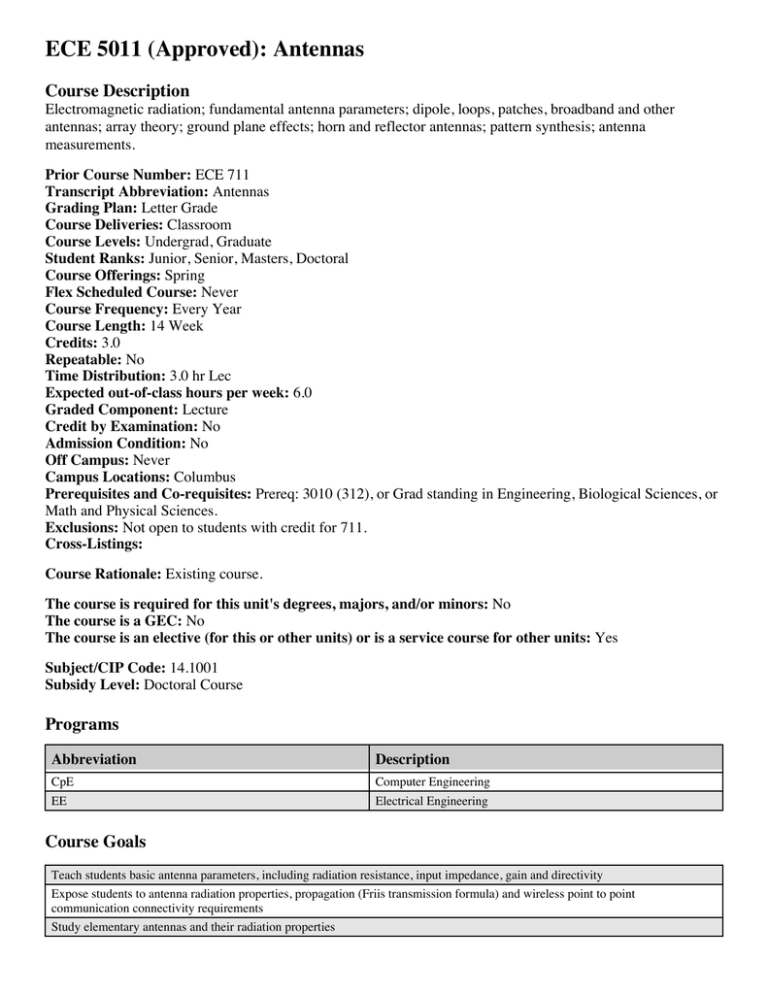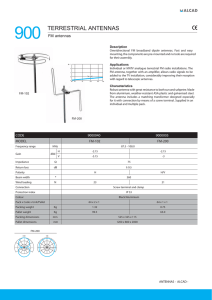ECE 5011 (Approved): Antennas - Department of Electrical and
advertisement

ECE 5011 (Approved): Antennas Course Description Electromagnetic radiation; fundamental antenna parameters; dipole, loops, patches, broadband and other antennas; array theory; ground plane effects; horn and reflector antennas; pattern synthesis; antenna measurements. Prior Course Number: ECE 711 Transcript Abbreviation: Antennas Grading Plan: Letter Grade Course Deliveries: Classroom Course Levels: Undergrad, Graduate Student Ranks: Junior, Senior, Masters, Doctoral Course Offerings: Spring Flex Scheduled Course: Never Course Frequency: Every Year Course Length: 14 Week Credits: 3.0 Repeatable: No Time Distribution: 3.0 hr Lec Expected out-of-class hours per week: 6.0 Graded Component: Lecture Credit by Examination: No Admission Condition: No Off Campus: Never Campus Locations: Columbus Prerequisites and Co-requisites: Prereq: 3010 (312), or Grad standing in Engineering, Biological Sciences, or Math and Physical Sciences. Exclusions: Not open to students with credit for 711. Cross-Listings: Course Rationale: Existing course. The course is required for this unit's degrees, majors, and/or minors: No The course is a GEC: No The course is an elective (for this or other units) or is a service course for other units: Yes Subject/CIP Code: 14.1001 Subsidy Level: Doctoral Course Programs Abbreviation Description CpE Computer Engineering EE Electrical Engineering Course Goals Teach students basic antenna parameters, including radiation resistance, input impedance, gain and directivity Expose students to antenna radiation properties, propagation (Friis transmission formula) and wireless point to point communication connectivity requirements Study elementary antennas and their radiation properties Expose students to impedance matching techniques, and mutual coupling Study antenna arrays and array design methods. Introduce students to commonly used wideband antennas such as spirals and log-periodics Introduce students to aperture antennas such as horns and reflectors Course Topics Topic Lec Review: Maxwell?s equations; boundary conditions; complex Poynting vector; real and reactive power; vector and Hertz potentials; radiation integral; duality; reciprocity 4.0 Radiation by simple sources; antenna parameters and characterization properties: radiation resistance, radiation intensity, directivity and gain, effective aperture; Far-zone and Fresnel regions 5.0 Elementary antennas and their properties; dipoles; loop antennas 6.0 Linear and planar arrays; phased arrays; endfire arrays; Chebychev arrays and design techniques 7.0 Impedance matching; mutual impedances 3.0 Broadband antennas; matching techniques; folded dipole; helical and Yagi-Uda antennas; spiral and log periodic antennas; traveling wave antennas 6.0 Microstrip antennas 3.0 Aperture antennas; horns and reflectors; equivalence principle 6.0 Rec Lab Cli IS Sem FE Wor Representative Assignments Homework 1: problems to review: (a) wave propagation and polarization, (b) plane wave reflection from ground/earth, (c) bands used for wireless communications, TV, Radio and Wi-Fi, (d) student awareness of antennas and wireless communications in their daily life. Homework 2: problems to examine student understanding of basic antenna parameters, including patterns and far field. Homework 3: problems on simple/basic antenna radiation. Homework 4: problems on wireless connectivity of multiple antennas (Fris transmission formula) and radar detection. Homework 5: problems on antenna arrays and their design. Homework 6: problems on impedance matching, folded dipole and helical antennas. Homwork 7; problems on Yagi-Uda and microstrip antennas Homework 8: problems on wideband antennas, aperture antennas or horns Project: 3-week antenna design project; students can be given a design goal for a wireless application in their daily life. Frequency, bandwidth and gain requirements as well as size or application type are specified. Students are then asked to design such an antenna to satisfy pre-specified requirements. Grades Aspect Percent Homeworks delivered by the students 25% Midterm I 20% Project or Second Midterm 20% Final exam 35% Representative Textbooks and Other Course Materials Title Author Antenna Theory, Analysis and Design C. A. Balanis ABET-EAC Criterion 3 Outcomes Course Contribution College Outcome *** a An ability to apply knowledge of mathematics, science, and engineering. * b An ability to design and conduct experiments, as well as to analyze and interpret data. *** c An ability to design a system, component, or process to meet desired needs. * d An ability to function on multi-disciplinary teams. ** e An ability to identify, formulate, and solve engineering problems. f An understanding of professional and ethical responsibility. ** g An ability to communicate effectively. ** h The broad education necessary to understand the impact of engineering solutions in a global and societal context. ** i A recognition of the need for, and an ability to engage in life-long learning. * j A knowledge of contemporary issues. *** k An ability to use the techniques, skills, and modern engineering tools necessary for engineering practice. Additional Notes or Comments update prereqs to match university version. Prepared by: Betty Lise Anderson


![EEE 443 Antennas for Wireless Communications (3) [S]](http://s3.studylib.net/store/data/008888255_1-6e942a081653d05c33fa53deefb4441a-300x300.png)